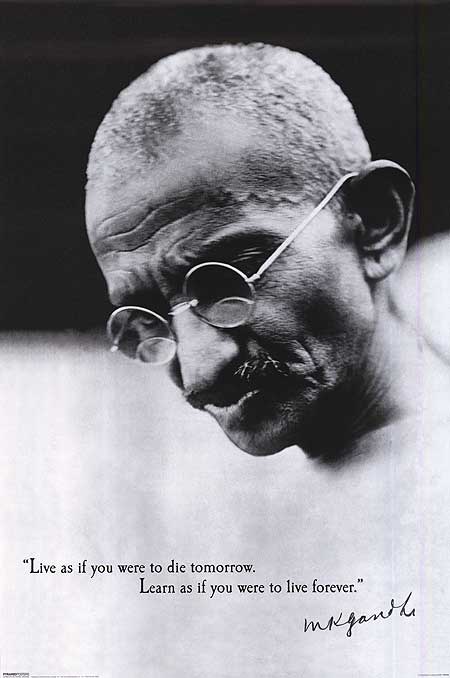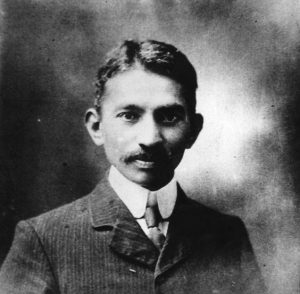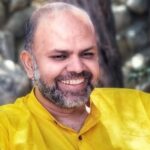On the occasion of Gandhi Jayanthi, the Ritambhara members engaged in a deep reflective dialogue on Gandhiji, his life, and his message. It seemed a fitting tribute to listen and let oneself be evoked by the many facets of Gandhiji that are brought alive in people today.
None of us can claim to know Gandhiji and every detail of his life accurately, but what we do aim through this reflective dialogue is to understand how Gandhiji’s philosophy, practices or way of life impacts our daily struggles to walk on the path of self-discovery. Is there a relevance of his struggle in our sAdhana and how does one move forward in this journey?
A: As a yoga therapist, I continuously confront the yamA-niyamA associated with leading one’s life. There are many instances like when I speak asatyam, it causes many knots in my body and the occurrences of many pulls-pushes within me as I navigate through life. I now wonder how Gandhiji did so much; he stood for the nation and had to battle many knots or double binds in life? I have not read a lot about him but enough to know that he was a strong person.
B: I was in a process work workshop recently when the facilitator asked me what are my aspirations? When I was trying to formulate the answer, I saw myself talk about the social, spiritual and scholarly India. I see Gandhiji as a central anchor for social India. That is how I relate to Gandhiji.
C: This morning after my yoga practice, there were two things that came to my mind-:
- I was filled with pride and gratitude for yoga and Gandhiji, because both are part of my rich heritage and most importantly they have contributed to my own inner processes in a big meaningful way
- Gandhiji was essentially a practitioner of yoga, whether he did asana/pranayama is another matter, but he followed the principles of yoga in his life. He was very disciplined in his life and was working very deeply with his inner processes. But more importantly he also shared his inner journeys with people in very creative and genuine ways. Thus, he touched people at a deeper level and authored many movements.
D: I have been trying to read about Gandhiji’s life out of curiosity and recently I watched the movie Gandhi. There was a scene between Jinnah and Nehru regarding the post of Prime Minister, just before India was declared independent. One saw Gandhiji’s body language as one who was so helpless and sad, that he just walks out of the room. Yet later, he does what he thinks needs to be done; for the larger purpose. Personally, I am at a similar situation with so many things happening around me that I feel helpless and ask myself daily ‘what do I do? I feel lost’
E: I too have not read too much about Gandhiji and have watched the movie once or twice. But what always stuck to me right from the beginning was his adherence to the truth and that truth will show the way eventually. I am at a situation of multiple double binds; one side is the plain truth and on the other side is the embellished truth that are really the lies spoken so as not to hurt people in the hope that it allows them to digest the truth better. The concept of satyAgraha comes to my mind while trying to stay with the truth and speaking it, this is a tapas for me right now. The reality of the nature of self, body and mind is sometimes so difficult to see, let alone be comfortable with and then trying to understand it! I am hoping to stay and navigate through these tough times with a strong sAdhana, which is what Gandhiji also did.
F: I studied about Gandhiji in my school and during my civil services exam, but the most important aspect of Gandhiji that I am still trying to understand deeply is ahimsA. How does ahimsA fit in with my personal yoga practices or even my relationships with others? I am hoping some of these questions would be answered soon. Since ahimsA is so central to yoga, Patanjali calls it a mahAvrata. It becomes all the more critical to understand Gandhiji in this context.
G: I also struggle with ahimsA because I keep fighting with the pulls and pushes that keep churning within me. I really wonder how Gandhiji used his methods of silence and quietude to get through the pulls and pushes in his life?
A: While one speaks the truth, there is no guarantee that it will not cause violence or an uproar, right? It need not be a physical violence but an emotional upheaval or violence too. So, it really amazes me how did he manage both satyam and ahimsA? How can both be balanced in today’s context?
B: I have read quite a few of Gandhiji’s writings and have been influenced by it as well, some of his questions are quite difficult to comprehend and spell out even now. On a recent visit to Rajasthan, memories of the first time two years ago I started engaging with Gandhiji’s concepts, came back to me. As I am rekindling the interest, I also want to start re-engaging with ahimsA, which has a relevance at an individual and collective level.

C: Well, from all the above, it is clear how Gandhiji and his philosophy are very important. He wrote about Swaraj, Satyagraha and Sarvodaya extensively and also practiced them in his life.
In the pursuit of attaining Swaraj (the book that Gandhiji wrote, where he elaborated his idea of independence Hind Swaraj and his other writings that elaborate on the idea) the most critical aspect is that unless I really understand the meaning of svaraj (the original Sanskrit word meaning self-mastery, to differentiate it from the idea of national Independence) it becomes difficult for me to de-colonize my mind.
I find it very difficult to see that various ideologies and ‘isms’ that are doing the round and form the basis of our current discourse are false.
I use the concept of svaraj when working with activists or aspiring activists, because the starting point to understand Swaraj is the process of knowing oneself. A lot of inner process work that I facilitate focuses on understanding the self but also encourages a lot of self-disclosure.
Gandhiji practiced self-disclosure through his many writings. My Experiments with Truth being the most well known books that is full of honest self-reflection. This is in direct contrast to other leaders of his time and perhaps all time who wear many masks to hide their internal struggles and realities.
The point I am stressing is that one needs to keep examining oneself through continuous reflection and not hide it if one wants to understand ahimsA and satya. Surely, Gandhiji made many mistakes as he struggled with his inner demons, but that did not stop him from disclosing where he was and what his struggles were. This was his process of discovering Satyagraha. We must keep in mind that “Satyagraha” is a strong aggressive word rather than a passive single meaning. “I will act assertively based on satya”, it is not a coyly held opinion, but a constant endeavour to discover what truth is and how to unfold it through ones actions.
D: We are only discussing a small aspect of Gandhiji’s life but imagine what would his wife have had to go through? As I was reading his biography, I felt a sort of churn inside of me almost to the level of ‘bibhatsam’. While the ‘agraha’ for satyam would have been tough for him but it would have also been tough for people around him, it was not easy in any way for Kasturba. After all, it was not her discovery or insight!
A: I am quite interested to understand the meaning of truth here, since a lot of us have talked about the truth etc. For me, it is something that resides in me at this moment in time and I can reflect it honestly.

C: When you mentioned about Gandhji’s wife, she was actually a very strong woman. She was mobilizing a lot of women’s groups based on some of her husband’s ideas and struggle. The other poignant and very human side of Gandhiji is the way he tended to his wife when she was severely ill. He would get up at 3 am to finish his writing and then be by her side to attend to her needs. A lot has been written about it too, on how he used to keep mornings and evenings for her while managing his other responsibilities. One can read a lot of about his formulation of ideas of Satyagraha in South Africa written by Mary Graham Pollock when she was with him there. He seems to have stayed on his path, but also educated Kasturba.
B: When one reads about Gandhiji’s works, it is not that he does not hold opinions at a certain point of time but he is also in a constant dialogue with many people. He takes in ideas, and when something strikes him as true he incorporates it into his own line of enquiry, it just deepens his understanding. He keeps moving along and truth is not static or fixed. This commitment to uncovering something deeper and subtler is amazing.
C: There is a great element of bhakti within him and it can get tough for people living with him to understand this. Gandhiji’s narrative was not straightforward at all, there is so much said about his family life and tensions involving his elder son and him also.
D: Yes, he was a very demanding person and Kasturba would have had to struggle quite a bit. A fancy barrister from South Africa would have been expected to earn loads of money but instead he dedicated his life to understanding human dignity and suffering, which came up during his stay in South Africa very frequently.
B: It all started with his own quest for the truth and ahimsA with respect to his context rather than jumping into the larger arena immediately. The simple question ‘Am I free or what is my purpose’ etc., led him to serious self-reflection. The more he found inner freedom, and saw it resonate with others who were oppressed, it led him to seek a larger purpose and finally mobilizing many movements across the country and world. That to me was a huge deal, because of the kinds of difficulties he must have faced would have been unimaginable.
 A: Hmmm.. how that train journey in South Africa was a start of a movement of sorts no? A burning of the past and leaving behind that life. He never preached or forced others to follow suit, but people just started following him.
A: Hmmm.. how that train journey in South Africa was a start of a movement of sorts no? A burning of the past and leaving behind that life. He never preached or forced others to follow suit, but people just started following him.
F: It seems that every step of his was rooted in search for truth, which sparked an evocation in millions of others across the nation. Every action of his resonated deeply with people, whether it was his way of dressing or the Champaran movement, his search was indeed for a higher truth.
E: Why keep it so lofty? I can simply say that the start of the journey is discovering or enquiry into the self. Can we own up to our good and shadow parts? Can we be committed to this path despite the derailments and disappointments? The context and others may force you to behave in a certain way or follow a certain life, but can you be disciplined enough to follow the path that you truly believe in? Of course, it is not only tough for you but for everyone around like your family etc. What is the axis that I continue to act from? Lastly, having the trust that the higher powers will show you the way.
G: Gandhiji was very sensitive to his own processes and to others around, which we can see in so many of his writings and observations. He understood inner work like we are doing it now; throughout his writings he was not only disclosing his inner world whether good or bad but also trying to step back and observe. This is not only private sAdhana but also the start of creative expressions and even movements!
B: He embodied the Arjuna archetypal energy so well, holding the system and self in the purview simultaneously. No wonder he struck a chord with so many people! He also found a third dimension that transcended the self and system. This was no accident, but a certain kind of inner intelligence, sincerity and love for the land.
A: In other words, passion for all. It must have been a precarious balance of holding the self and system simultaneously and deepening his sAdhana, commitment to dharma, truth etc. so that he can walk on this razor thin path.


 Anoop is a student of Yoga, an entrepreneur, a coach and a father of two young boys. He has led successful leadership stints in both the corporate and non-for-profit sectors. On encountering the country’s water/farmer crises at close quarters, he decided to pause and examine the impact various ‘isms’ – capitalism, colonialism, etc., were having on us as individuals, families, the society and the environment at large. This quest led him to formally engage with traditional Indic knowledge systems while also learning from the latest advances in science – about our physical and mental wellbeing, importance of body and mind work in healing trauma and the urgent need for a conscious rebuilding of family / work / social structures if we have to thrive individually and collectively. Insights, frameworks and processes gleaned from these on-going studies, an anchorage in his own personal practice and his wide-ranging experiences is what Anoop brings to facilitation/coaching spaces in Ritambhara and his various professional engagements.
Anoop is a student of Yoga, an entrepreneur, a coach and a father of two young boys. He has led successful leadership stints in both the corporate and non-for-profit sectors. On encountering the country’s water/farmer crises at close quarters, he decided to pause and examine the impact various ‘isms’ – capitalism, colonialism, etc., were having on us as individuals, families, the society and the environment at large. This quest led him to formally engage with traditional Indic knowledge systems while also learning from the latest advances in science – about our physical and mental wellbeing, importance of body and mind work in healing trauma and the urgent need for a conscious rebuilding of family / work / social structures if we have to thrive individually and collectively. Insights, frameworks and processes gleaned from these on-going studies, an anchorage in his own personal practice and his wide-ranging experiences is what Anoop brings to facilitation/coaching spaces in Ritambhara and his various professional engagements.
 Priya is a Yoga therapist in the Krishnamacharya tradition. She adapts Reiki & energy work, Vedic chanting, life coaching & Ayurvedic practices in her healing spaces. She is committed to nurturing collectives that have the praxis of Yoga at their heart.
Priya is a Yoga therapist in the Krishnamacharya tradition. She adapts Reiki & energy work, Vedic chanting, life coaching & Ayurvedic practices in her healing spaces. She is committed to nurturing collectives that have the praxis of Yoga at their heart. Anisha has been on an exploration to understand herself through yoga for the last 15years which led her to teaching yoga, yoga therapy and inner work through yoga.
Anisha has been on an exploration to understand herself through yoga for the last 15years which led her to teaching yoga, yoga therapy and inner work through yoga. Apoorva chanced upon Yoga in her early 20s. A spark was lit within and there was no turning back. Her exploration led her to the Krishnamacharya tradition more than a decade ago. Curious about human behaviour and what drives it, she was thrilled when her search ended (and also began) when she first came upon the Yoga Sutra, which illuminated a path towards answering many questions that had been held for a long time.
Apoorva chanced upon Yoga in her early 20s. A spark was lit within and there was no turning back. Her exploration led her to the Krishnamacharya tradition more than a decade ago. Curious about human behaviour and what drives it, she was thrilled when her search ended (and also began) when she first came upon the Yoga Sutra, which illuminated a path towards answering many questions that had been held for a long time. Anita is a yoga teacher and therapist in the tradition of Sri.T.Krishnamacarya and Sri T.K.V. Desikachar, a Reiki practitioner and a Life Coach. She is also the founder of Vishoka, a center for learning Indic and energy-based frameworks for living and healing. Her deep concern for human suffering and the problems of unsustainable living kept her on the path of seeking an integrated approach to looking at life, living, learning and healing.
Anita is a yoga teacher and therapist in the tradition of Sri.T.Krishnamacarya and Sri T.K.V. Desikachar, a Reiki practitioner and a Life Coach. She is also the founder of Vishoka, a center for learning Indic and energy-based frameworks for living and healing. Her deep concern for human suffering and the problems of unsustainable living kept her on the path of seeking an integrated approach to looking at life, living, learning and healing. Ankit is a seeker in the wisdom traditions of India. The core of his work includes creating dialogic spaces where people can look within and see the connection between their inner and outer lives. Inspired by the likes of Gandhi, Aurobindo, Vivekananda and Guru Gobind his experiments in service took him back to his roots in Punjab where he is creating a community-led model of higher education which is open, inclusive and accessible for all. Ritambhara for him is a space for engaging in a community which is committed to a DHramic life. He anchors his work of learning and leadership in the Antaranga Yoga Sadhana and the humanistic wisdom of Mahabharata.
Ankit is a seeker in the wisdom traditions of India. The core of his work includes creating dialogic spaces where people can look within and see the connection between their inner and outer lives. Inspired by the likes of Gandhi, Aurobindo, Vivekananda and Guru Gobind his experiments in service took him back to his roots in Punjab where he is creating a community-led model of higher education which is open, inclusive and accessible for all. Ritambhara for him is a space for engaging in a community which is committed to a DHramic life. He anchors his work of learning and leadership in the Antaranga Yoga Sadhana and the humanistic wisdom of Mahabharata.